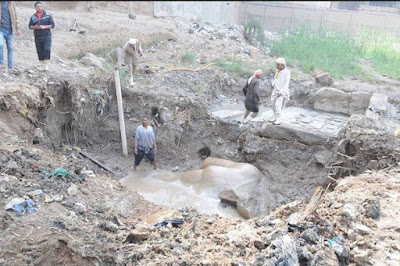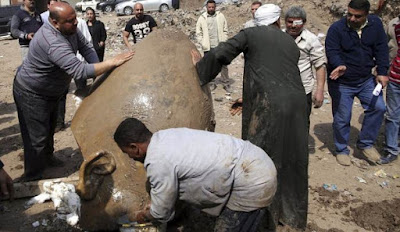Archaeologists in Egypt and Germany have found an eight-meter quartzite statue submerged in the bottom of a pit in a poor neighborhood of Cairo that is likely to represent the revered Pharaoh Ramses II, who ruled more than 3,000 years ago.
The discovery, described by the Ministry of Antiquities of Egypt as one of the most important in history, was made near the ruins of the temple of Ramses II in the ancient city of Heliopolis, located in the eastern part of what is the current Capital of Egypt.
Pharaoh, the most powerful and celebrated ruler of ancient Egypt, also known as Ramses the Great , was the third of the nineteenth Dynasty and occupied the throne between 1279 and 1213 BC. He led several military campaigns and extended the Egyptian empire from Syria in the east to Nubia (now Sudan) in the south.
"We found the bust of the statue and the lower part of the head and now we remove the head and find the right crown and ear and a fragment of the right eye," said the Minister of Antiquities Khaled al-Anani.
Archaeologists also found the top of a statue of Pharaoh Seti II, grandson of Ramses II, 80 centimeters long.
The Temple of the Sun at Heliopolis was erected by Ramses II, which gives weight to the possibility that the statue represents it, according to archaeologists. This was one of the largest temples in Egypt, almost twice the size of Karnak, in Luxor, but was destroyed in the Greco-Roman era. Many of its obelisks were moved to Alexandria or Europe and stones were looted from the place for use in other constructions as Cairo grew.
The discovery was made in the working class area of Matariya (the ancient Heliopolis) between muddy streets and unfinished buildings. According to Dietrich Raue, head of the German team, the ancient Egyptians believed that Heliopolis was the place where the sun god lived. The experts will try to extract the remaining pieces of both statues for restoration. If they succeed and the colossus represents Ramses II, the statue will be placed at the entrance of the Great Egyptian Museum, which will be inaugurated in 2018.
The discovery, described by the Ministry of Antiquities of Egypt as one of the most important in history, was made near the ruins of the temple of Ramses II in the ancient city of Heliopolis, located in the eastern part of what is the current Capital of Egypt.
Pharaoh, the most powerful and celebrated ruler of ancient Egypt, also known as Ramses the Great , was the third of the nineteenth Dynasty and occupied the throne between 1279 and 1213 BC. He led several military campaigns and extended the Egyptian empire from Syria in the east to Nubia (now Sudan) in the south.
"We found the bust of the statue and the lower part of the head and now we remove the head and find the right crown and ear and a fragment of the right eye," said the Minister of Antiquities Khaled al-Anani.
Archaeologists also found the top of a statue of Pharaoh Seti II, grandson of Ramses II, 80 centimeters long.
The Temple of the Sun at Heliopolis was erected by Ramses II, which gives weight to the possibility that the statue represents it, according to archaeologists. This was one of the largest temples in Egypt, almost twice the size of Karnak, in Luxor, but was destroyed in the Greco-Roman era. Many of its obelisks were moved to Alexandria or Europe and stones were looted from the place for use in other constructions as Cairo grew.
The discovery was made in the working class area of Matariya (the ancient Heliopolis) between muddy streets and unfinished buildings. According to Dietrich Raue, head of the German team, the ancient Egyptians believed that Heliopolis was the place where the sun god lived. The experts will try to extract the remaining pieces of both statues for restoration. If they succeed and the colossus represents Ramses II, the statue will be placed at the entrance of the Great Egyptian Museum, which will be inaugurated in 2018.

















0 comentarios:
Publicar un comentario